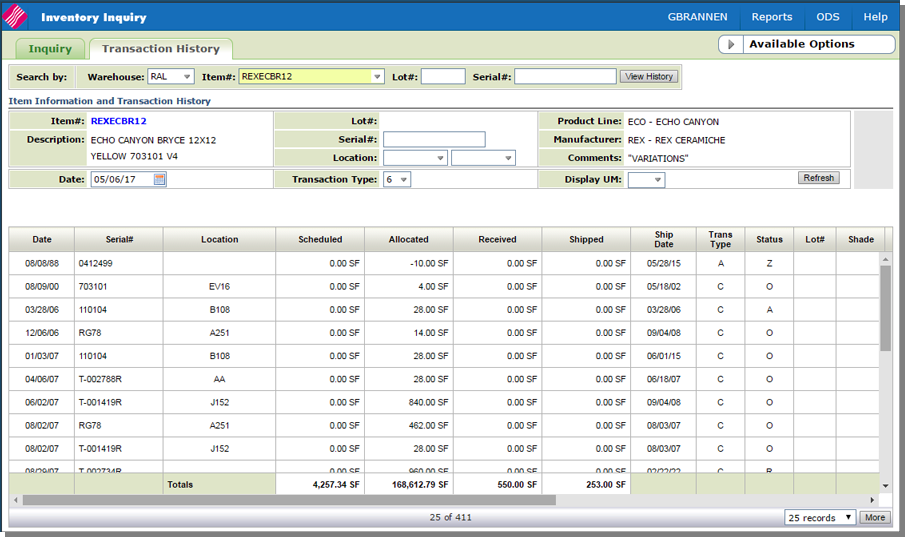Transaction History
The transaction history displays each transaction in chronological order. It relates to the specified item at the specified warehouse and, if applicable, for the specified lot and serial number. The system creates and maintains a separate stock card for each item at each warehouse.
Click on the Transaction History tab allows you to search by several different parameters.

Use the Search by parameters at the top of the screen to narrow the search as needed.
If you enter a date, the history appears starting from that date. By default, the date is set to start at the last month of activity. You can change the date, or remove the date to show all transactions currently on the system for that item or warehouse number.
All open customer orders or open purchase orders display even if they are prior to the selected date.
To convert quantities to a specific unit of measure, enter the unit of measure in the Display UM field.
The following table describes the transaction history information.
| Information | Description/Instructions |
| Date | This is the transaction date which effects the availability of stock. It is the date of the transaction; except for purchase orders and incoming transfers in which case it is the estimated time of arrival, and customer orders in which case it is the order date. The order date is not always the date on which the order was entered. At the time of entering an order, Order Entry operators can override the Order Date to allocate the inventory at a later date. Future orders are entered with the order date overridden to the date on which material is expected to be available. |
| Scheduled | These are the quantities scheduled on order from suppliers. These quantities are posted by the Purchase Order Entry System. |
| Allocated | These are the quantities allocated to customer orders that have not yet been invoiced. A negative in this column indicates an open return authorization or credit. These quantities are posted by the Order Entry System. |
| Received | These are the quantities physically received into stock. A negative amount in this column indicates an adjustment which decreased stock. |
| Shipped | These are the quantities physically shipped from stock. A negative amount in this column indicates a credit with stock returned. |
| Ship Date | This is the date that a customer order is scheduled to be shipped or picked up from the warehouse, or that a purchase order is scheduled to be shipped by supplier. An entry of 02/22/22 indicates that a ship date was not entered. |
| Trans Type |
Indicates the type of transaction. These codes are system defined. Some examples are:
|
| Status |
The status codes can vary depending on the Transaction Type. Some examples are: For Transaction Type: A - Adjustment
Adjustment transaction codes are created and maintained through the ADJSTCODES table in System Tables Maintenance (SET 29). Transaction Types: C - Customer Order and P - Purchase Order
For customer orders and purchase orders, these status codes can be updated using option 13, Update Order Status and Shipping Data, on the Customer Orders Menu or Purchase Orders Menu. They can significantly enhance your ability to service customer inquiries. For example, you can quickly enter an R code on a purchase order when received. If work is backlogged, the actual receipt could take hours or even days until it is processed. The R code alerts all users that the material is in-house and can be sold. Status codes for orders are created using SET 7 - Order & Serial# Status Codes. You can also go to SET 7 to view a complete list of codes. H - Temporary Hold
|
| Onhand | This is the quantity physically on-hand for the date specified. A negative amount in this column indicates that stock was invoiced prior to being received, or that an inaccurate physical count or adjustment was entered into the computer. |
| Net Available | This is the quantity available as of each date listed. It takes into consideration all transactions including customer orders and purchase orders. These available-by-date figures are significantly different and more informative than the summarized available figure on the Inventory Inquiry screen. The summarized figure is quantity onhand less customer orders. This screen expands on that figure to show what will be available day by day. Additionally, this screen includes temporary holds code HH, which are not deducted from the summarized figures. |
| Reference | The information in this field changes according to the transaction type. For example, for holds it can display the initials of the person who put the inventory on hold and the workstation that was used. |
Click a Transaction to display its details.
For adjustments, the program where the adjustment was made is recorded and then displayed in the Description box.

The current adjustment program codes are:
- AI - Adjustment by Item# - menu option INV 2 (IVADJ1)
- AL - Adjustment by Location - menu option INV 10 (IVAJD4)
- AP - Adjustment by API - IWMS menu (EF048R)
- AS - Adjustment by Serial# - menu option INV 2 (IVADJ2)
- CC - Adjustment by Cycle Count - Cycle Count menu CYC (IVCCUP)
- II - Adjustment in Inventory Inquiry - menu option INV 1
- I5 - Adjustment by - System Maintenance Special Update (IVAUD5)
- MW - Adjustment by Mass Writedown - menu option INV 8 (WRTD01)
- NI - Inventory quantity adjustments made in Navigator.
- TR - Transfer API - Receipt of Transfer (EF040R)
- WH - Warehouse Move - menu option IWMS
- WS - Adjustment by Writeoff Small Qty - System Maintenance Special Update (IVWO01)
- 11 - Adjustment by System Maintenance Special Update (IVAUD11)
